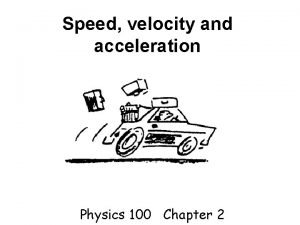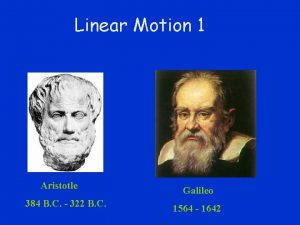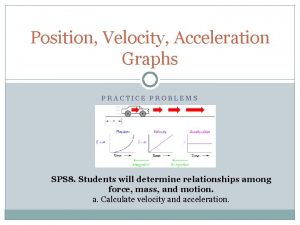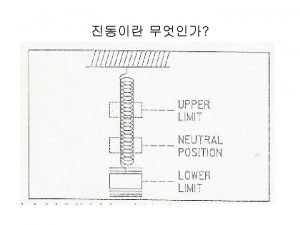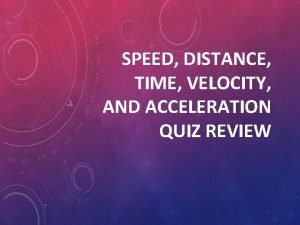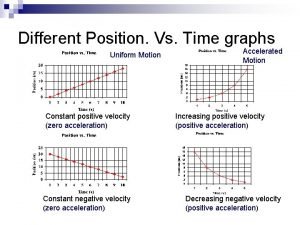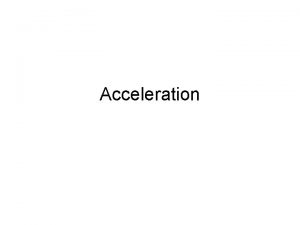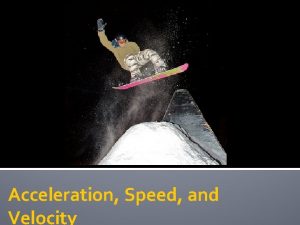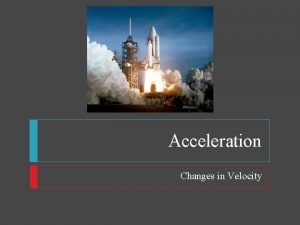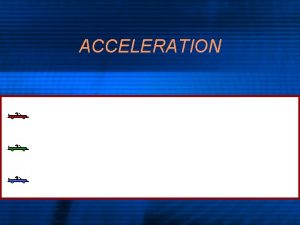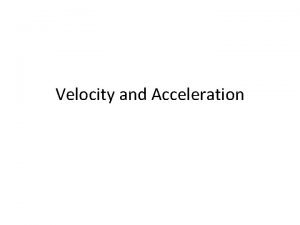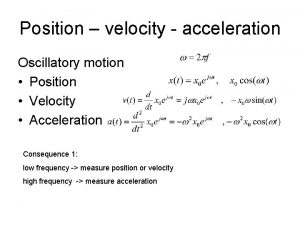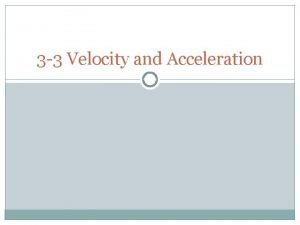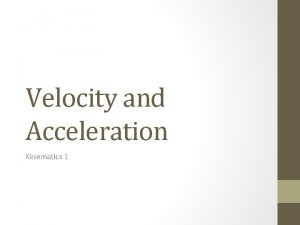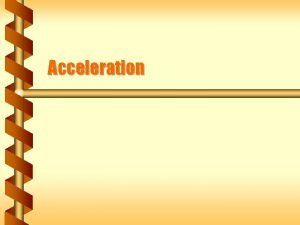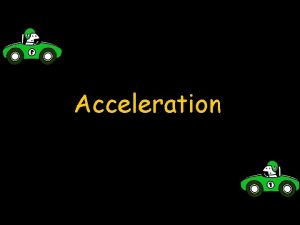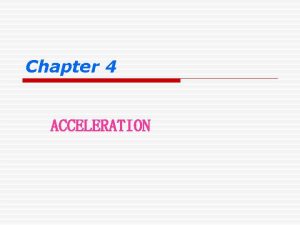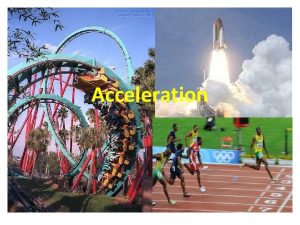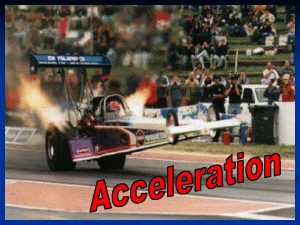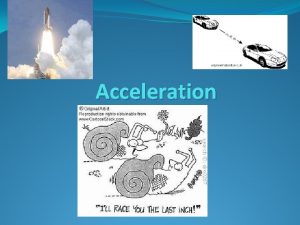Acceleration Changing velocity A change in velocity occurs


















- Slides: 18

Acceleration

Changing velocity… A change in velocity ( ) occurs when the speed of an object changes and/or its direction of motion changes. n A change in velocity can be calculated by: n = change in velocity = final velocity =initial velocity

Cases for a change in velocity Speed up Case 1: Positive Acceleration - A dragster has an initial velocity of 1 km/h and a final velocity of 85 km/h. What is its change in velocity? Case 2: Negative Acceleration - Returning space shuttle lands with an initial speed of 500 km/h before coming to a stop. What is its change in velocity? Case 3: Directional Acceleration Slow down

CLARIFYING ACCELERATION Velocity Direction Acceleration SO ACCELERATION IS NON-UNIFORM MOTION

Non-uniform motion is when a body moves unequal distances in equal intervals of time or vice-versa. 12. 5 m/s 0 s 1 s 25. 0 m/s 2 s 37. 5 m/s 3 s 50. 0 m/s 4 s The car moves as follows: TIME (s) Velocity (m/s) 0 0 1 12. 5 2 25. 0 3 37. 5 4 50. 0 The slope of a velocity-time graph is the average acceleration of the object.

On a velocity-time graph, the slope is equal to the acceleration: - A positive slope means the acceleration is positive and velocity is increasing at a constant rate - A zero slope means the acceleration is zero and the velocity is constant - A negative slope means the acceleration is negative and velocity is decreasing at a constant rate

A drag racer gets the green light and hits the gas and moves forward by speeding up. Its velocity vs. time graph is below. What is the car’s acceleration? The slope of a velocity-time graph is the average acceleration of the object.

Calculating Acceleration!! � Acceleration : The change in velocity divided by the change in time. �Equation: �Units are m/s 2

A car is at rest, accelerates for 5 s and its final velocity is measured at 10 m/s forward. What is the car’s acceleration? a = (10 m/s – 0 m/s) 5 s a = 2 m/s 2 forward

The Japanese bullet train accelerates from rest to 2. 0 m/s 2 forward for 37 s. What is the velocity at the end of the 37 s? = (2. 0 m/s 2) (37 s) = 74 m/s forward

A Chevette (car) is travelling North at 22 m/s. How long would it take to slow this car to 12 m/s if it accelerates 2. 5 m/s 2? = = = - 12 m/s -2. 5 m/s 2 -10 m/s = 4. 0 s -2. 5 m/s 2 to slow the car

A Skier moving 6. 0 m/s forward begins to slow down, accelerating at 2. 0 m/s 2 for 1. 5 s. What is the skier’s velocity at the end of the 1. 5 s? Vf - Vi = a ∆t Vf = a ∆t + Vi Vf = -2. 0 m/s * 1. 5 s + 6. 0 m/s Vf = 3. 0 m/s forward

Measuring Reaction Time Distance (inches) 1 2 3 4 5 6 7 8 10 12 14 16 18 Time (sec. ) 0. 07 0. 10 0. 12 0. 14 0. 16 0. 17 0. 19 0. 20 0. 23 0. 25 0. 27 0. 29 0. 30 Release Catch Typical reaction time is 0. 20 to 0. 25 seconds.

Free Fall � Your speed increases (acceleration) when you fall because of graivty � Your acceleration is 9. 8 m/s 2 � Always assign the acceleration due to gravity as a negative, i. e. 9. 8 m/s 2.

Suppose a rock falls from the top of a cliff. What is the change in velocity of the rock after it has fallen for 1. 5 s? (Assign “down” as negative (-)) = (-9. 8 m/s 2)(1. 5 s) = -15 m/s

A ball is thrown straight up into the air at 14 m/s. How long does it take for the ball to slow down to an upward velocity of 6. 0 m/s? = (6 m/s - 14 m/s) -9. 8 m/s 2 = 0. 82 s

A rock is thrown downwards with an initial velocity of 8. 0 m/s. What is the velocity of the rock after 1. 5 s? Vf – Vi = a∆t Vf = a∆t + Vi = (-9. 8 m/s 2)(1. 5 s) + (-8. 0 m/s) = 22. 7 m/s

� Air resistance will increase as it falls faster � Eventually gravity will balance with air resistance � Now you fall at constant velocity and acceleration is zero � This is called terminal velocity - highest speed reached by a falling object. � Sky-divers can reach an average of 320 km/h Falling & Terminal velocity
 Final velocity initial velocity acceleration time
Final velocity initial velocity acceleration time Deceleration on velocity time graph
Deceleration on velocity time graph Centripetal acceleration vs centripetal force
Centripetal acceleration vs centripetal force Centripetal acceleration tangential acceleration
Centripetal acceleration tangential acceleration Linear quantity
Linear quantity Radial acceleration formula
Radial acceleration formula Angular acceleration and linear acceleration
Angular acceleration and linear acceleration Derivatives of position
Derivatives of position What is acceleration
What is acceleration Velocity and acceleration difference
Velocity and acceleration difference Velocity and acceleration
Velocity and acceleration Negative velocity negative acceleration
Negative velocity negative acceleration Position, velocity acceleration graphs practice
Position, velocity acceleration graphs practice Velocity polygon examples
Velocity polygon examples Vibration displacement velocity acceleration
Vibration displacement velocity acceleration Quickchek menu
Quickchek menu Speed, velocity and acceleration quiz
Speed, velocity and acceleration quiz Formula of km/h
Formula of km/h Constant leftward velocity
Constant leftward velocity










